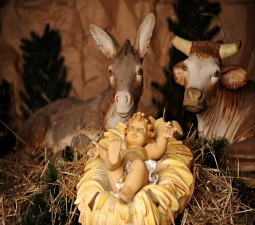Pope: God Offers His ‘Omnipotent Love Through the Fragile Figure of a Child’
The Vatican Christmas tree was lit for the first time on Dec. 19. The St. Peter's Square Nativity was also unveiled. The Holy Father said: 'The crèche and the tree bring a message of light, hope and love.'

VATICAN CITY — The 83-foot Italian tree in St. Peter's Square was lit for the first time at the unveiling of the Vatican's Nativity scene, which Pope Francis called a sign of “light, hope and love” for the world.
The Nativity scene and the Christmas tree “are an invitation to unity, harmony and peace; an invitation to make room, in our personal and social life, for God,” the Pope said in a Dec. 19 audience with delegates of the Italian regions who donated the decorations at a special “Lighting Ceremony” held in St. Peter’s Square.
In the birth of Jesus, we see that God “does not come with arrogance, imposing his power, but, instead, offers his omnipotent love through the fragile figure of a Child. The crèche and the tree, therefore, bring a message of light, hope and love,” he said.
Donated to the Vatican by the southern Italian region of Calabria, where Pope Francis visited in June, this year's tree is 70 years old, stands 83.6 feet tall and weighs eight tons.
A unique characteristic of the tree is that it has what is called a “twin trunk,” in which two separate trunks have been fused together into one. It is a symbolic feature and is often used to show that man is never alone on his journey but is always accompanied by the Lord.
The scene, entitled “The Nativity Scene in Opera,” contains figures that were donated by the Verona for the Arena foundation and draw their inspiration from famous opera productions staged in the Verona Opera Arena, particularly Gaetano Donizetti’s comic opera The Elixir of Love.
With the emphasis on opera, the Nativity’s title and design are meant to be a play on the two meanings of the Italian word “opera,” which can refer to either a theater production or the verb “to work.”
Given this background, the “Nativity Scene in Opera” is also meant to emphasize the work that God did through the birth of his son, Jesus Christ.
In his audience with representatives of the regions who donated the Nativity and the tree, Pope Francis praised them for “enriching” their culture with literature, art and music, saying that they are a valuable heritage for future generations.
“The Nativity and the Christmas tree are evocative festive symbols very dear to our Christian families,” he said, noting how they remind us of Christ’s incarnation, who was made flesh in order to save us, as well as the light Jesus brings to the world through his birth.
They are symbols that touch the hearts of all, he said.
They serve as a calling “(for the) people of our time to rediscover the beauty of simplicity, sharing and solidarity,” the Pope observed, saying that the tree and the Nativity are an invitation to create peace and harmony by allowing God to enter into our lives.
He recalled how Jesus, as the Messiah, became man and lived among us in order to cast out the darkness of sin and error and to bring his own divine light to humanity.
“Jesus himself says of himself: 'I am the Light of the world; whoever follows me will never walk in darkness but will have the light of life,'” the Holy Father said, and he encouraged all to follow Christ and bring his light to others.
“Let us follow him, the true Light, so as not to lose our way, and in turn to reflect light and warmth on those who go through moments of difficulty and inner darkness.”
- Keywords:
- christmas story
- christmas tree
- nativity scenes

















